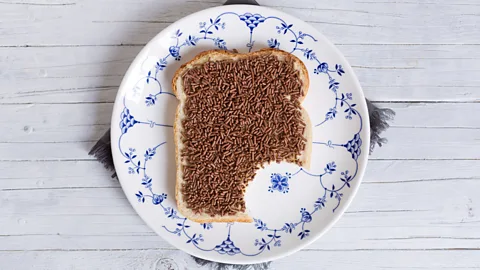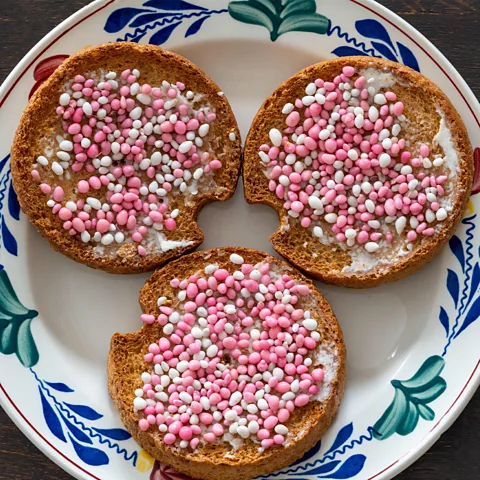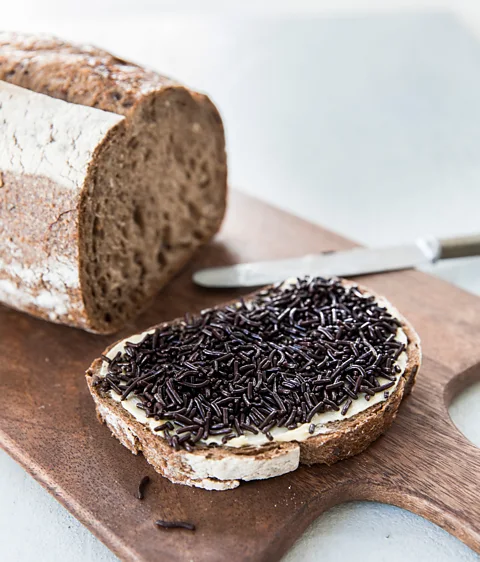The sweet Dutch sandwich that makes no sense
 Getty Images
Getty ImagesThere's a pervasive belief in the Netherlands that this unconventional meal helps lift the national mood.
"I think I'm an addict, basically," says Marije Nicklin, who grew up on the Dutch island of Terschelling. The Dutch expat, who has been based in West Yorkshire, UK, since 2002, is obsessed with hagelslag, carefully rationing the packets her parents post to her and the bag-loads she brings back on the ferry. "I've got quite a lot in storage," she says. "I do start to twitch when I see the end is coming."
Translated as "hailstorm", hagelslag are crispy, oblong-shaped sugar strands, just a few millimetres long. They are most commonly chocolate-flavoured and coated in a shiny glaze. In a supermarket in any other country, you'd likely see them in the cake toppings section reserved for a special occasion, but in the Netherlands, where more than 14 million kilograms of hagelslag are consumed per year, many people eat them every week, sprinkling them liberally onto buttered bread as a quick breakfast, snack or lunch. The hagelslag sandwich (broodje hagelslag) is surely an anachronism in this age of sugar awareness, but there's a pervasive belief in the Netherlands that this unconventional meal helps lift the national mood.
Good hagelslag is crunchy on impact but then melts in the mouth. Each season sees new variations appear in the shops: little bunnies for Easter, for example, or orange hagelslag for Koningsdag, an annual orange-themed street party to celebrate the King's birthday. The small packs seen in many hotel breakfast buffets are ideal for novices, and a few years back, one supermarket even experimented with pick 'n' mix. Whichever variety you choose, the habit is widespread, with an estimated 750,000 hagelslag sandwiches consumed each day.
Strictly speaking, hagelslag is a sugar-based vermicelli sprinkle that is chocolate or fruit-flavoured, but the name has become associated with other cheerfully packaged sugary toppings found on the same supermarket shelf, such as curly vlokken (chocolate flakes) and muisjes, sugar-coated aniseed seeds that look like tiny mice and are typically served on beschuit (rusks). In the 17th Century, aniseed was thought to aid lactation and help the womb contract, and pink or blue muisjes on beschuit are still served today to celebrate the arrival of a baby.
 Alamy
AlamyFor Nicklin, whose favourite variety is the puur (dark chocolate), the crunchiness is very important. "It's the bite with hagelslag. I don't think you can get that with any other spread," she says. "It still makes me feel happy." She bats back any suggestion that this sweet sandwich is messy to eat, explaining that her family use high-sided plates to catch any stray strands, which she insists are returned empty. "It's a crime to leave any on the plate," she says.
The first sugary toppings, in the form of aniseed muisjes, are thought to date to the late 19th Century when Cornelius Rutgerus de Ruijter sold them from his bakery in Baarn in the province of Utrecht. The brand, now known as market leader De Ruijter, expanded their production to factory-made fruit hagelslag in 1928 and chocolate hagelslag and flokken in the 1950s.
World's Table
BBC.com's World's Table "smashes the kitchen ceiling" by changing the way the world thinks about food, through the past, present and future.
Even Dutch royalty loved the sugary treat. King Willem III made the brand a purveyor of the court in 1883. And in 1985, under Queen Beatrix, De Ruijter received the Koninklijk (royal) predicate, an honour, a spokesperson from parent company Kraft-Heinz told BBC Travel, which "can only be carried by Dutch companies who have been officially recognised for their important position within their discipline, are at least 100 years old and are considered of national importance". Quite a fanfare for a modest chocolate sprinkle.
On an industrial estate in Tilburg – a short distance from the border with Belgium, wheresprinkles are commonly called muizenstrontjes (mouse droppings) − an immense but unremarkable building houses the world's largest hagelslag factory. Photographer Jordy Leenders from Eindhoven is one of the lucky few who has seen inside. Commissioned in 2018 to take photographs of its inner workings, he said he felt, "like I was Charlie, being invited to the chocolate factory for a tour".
Having gone through a machine that rid him of dust and disinfected his hands and arms, Leenders, kitted out in ear defenders and factory scrubs, emerged into a space filled by what he describes as a kind of "indoor rollercoaster… crisscrossing the room" made up of "mazes" of vast conveyor belts moving the hagelslag through different stages of preparation to perfect their size, texture and shape.
"Though the smell of chocolate is strong in the early stages when you're working with a raw material, it's the noise that really hits you," he says, describing the sound of the hagelslag being emptied from the silos "like pouring 2,000kg of rice into a bucket".
 Getty Images
Getty ImagesHe notes that one of the most memorable sights was the extrusion process, which creates "a very long string of hagelslag that they break off and cut" before spraying it with a fine mist of sugar to give it its appealing gloss. Leenders was astounded by the "absurd scale" of the factory and the complex processes required "in order to deliver a decoration to put on your sandwich". "When you have it in your hands, you're thinking that it is pretty simple," he says.
For newcomers to the Netherlands, it's the foodstuff itself that can be baffling. Colleen Geske, who moved to Amsterdam from Canada in 2005, has a clear memory of the first time she encountered hagelslag. Her first employer in the Netherlands shared a cafeteria with various tech, finance and law firms. "Every lunch hour, I would see these tables of men in suits that were eating what I could only describe as the lunch of a four-year-old," recalls the author of Stuff Dutch People Eat and co-host of the Stuff Dutch People Like podcast. "They were all with cartons of milk and having their bread with hagelslag. To me, it was such a bizarre sight."
"Hagelslag tells us a lot about the Dutch," Geske adds. "When you strip it away, the Dutch are not pretentious at all. They don't care what people think of them often… They're not over-analysing this, thinking: Is this healthy? Is this for children? They're just indulging in a relatively simple pleasure."
Hagelslag occupies a special place in a cuisine, which is in general, "quite practical, quite basic", she adds. "Hagelslag is the one kind of sparkly, shiny, interesting, funny, kind of quirky thing about a Dutch meal."
More like this:
• Is the future of French cheese at stake?
But the tradition of eating this illogical little lunch is not all about the taste, she notes. "I think, personally, that it's also this feeling of nostalgia that the Dutch have around eating hagelslag. It's like that one thing that you grew up with as a kid that you're still 'allowed' to do as an adult." Due to its high sugar content, her own children are only allowed it at weekends. They're very specific about how it must be made, telling Geske: "No, you need more butter and you have to put way more hagelslag on, and it has to be evenly distributed to the very edges..."
 Kraft-Heinz
Kraft-HeinzLeenders admits that the Dutch are eating "basically a crushed chocolate bar on their sandwich", which, he says, "doesn't really make sense if you're looking at it from a nutritional perspective". But that has never put him off. "I've been raised in the Netherlands so I'm a frequent hagelslag eater," he says. "I don't think you will encounter any Dutch household without at least one pack of hagelslagin their kitchen cabinets."
As far as Leenders is concerned, there's nothing childish about hagelslag. "It's for all ages," he insists. "I know people over 60 who still start their day with a sandwich with hagelslag on top of it."
"I struggle to get it in my head why they think it's for children," agrees Nicklin. "My dad always had hagelslag on his bread. And she can't think why anyone would think a hagelslag sandwich makes no sense: "If that's what they believe, then they're obviously not Dutch."
--
If you liked this story, sign up for The Essential List newsletter – a handpicked selection of features, videos and can't-miss news, delivered to your inbox twice a week.
